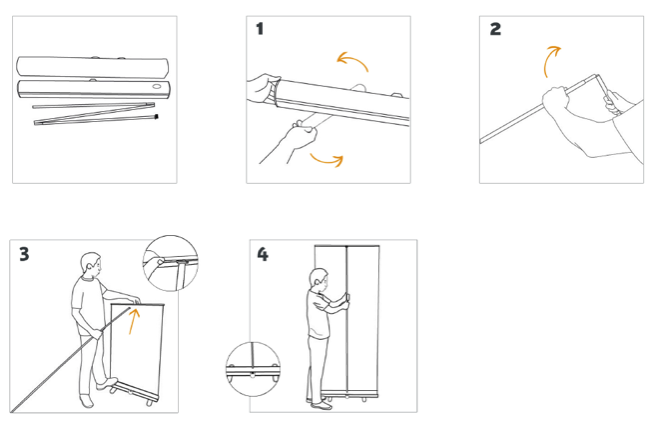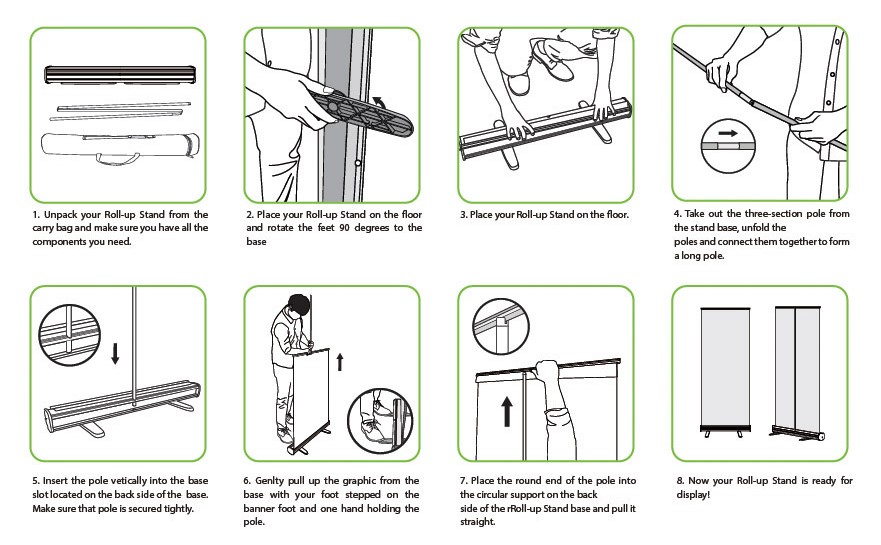Looking for in-depth information on roller banners? So, here it is. A roller banner is a rolling banner that comprises a visual that can be rolled into and out of a base unit. More simply, the roller banner is a popular lightweight display platform for large prints. Typically, vinyl or polypropylene is used for the base, while aluminum is used for the graphic area.
Portable roller banners are a common form of advertising signage at trade shows and conventions. Names like “roll up banners,” “pull up banners,” “penguin stands,” and “pop up displays” all refer to the same thing: roller banners.
Wherever space is confined, a roller banner can be unrolled and put to good use. Because of their vertical form, they are ideal for trade shows and other events with limited space. For the same reasons, they are a great choice when wall space is limited.
Types of Roller Banners

Now let’s take a closer look at the various options and see what each type offers. You can choose the kind of roller banner that’s necessary based on your design needs, budget, and intended display location. Here are a few examples.
Retractable Roller Banners
Retractable banners stand-alone with banner stands. This stand, also called a roll-up banner stand, has a spring-like structure that rolls the banner back into its base after you’re done displaying it. Because of this, these banners are the best option for any event, conference, or trade fair that requires advertising.
Cassette Roller Banners
Cassette roller banners allow for speedy image changes without requiring a re-setup of the entire display. They are therefore ideal for active and frequent exhibits. You can quickly reload the printed graphics because the cartridge is easily removable. If you plan on switching out your banner’s design frequently without shelling out for a new stand, a cassette banner stand is a way to go.
Tension Pole Roller Banners
Tension banners are banners with a simple frame that gets their rigidity and durability from the tension within the cloth or vinyl panel. Typically, a retractable pole and clamp bars at the top and bottom are used to secure the graphics panel.
Tension banners, which are lightweight and inexpensive, use a support pole to tension their vinyl display. These display options are portable, inexpensive, and flexible in terms of form factor.
Double-sided Roller Banners
With two printed panels on one sturdy roller banner system, double-sided roller banners are twice as effective. Both panels can be extended simultaneously to make a double-sided stand, or they can be used separately to carry two different messages. Expos and shopping malls are ideal places to hang double-sided banners since they provide maximum exposure from all directions.
Outdoor Roller Banners
The Outdoor Roller Banner Stand is a durable display option for usage in the outside environment. Twisting out the two extra-long feet reveals peg holes that can be driven into soft ground. Just pull off the feet, peg it down, and draw up the panels for a quick and easy installation at any outdoor fair, expo, or market pitch.

Choosing the Right Roller Banner
Roller banners are among the most flexible and affordable trade show presentations. They’re popular with expo veterans and newbies because of their vast graphic space, easy setup, and portability.
Due to their appeal, the market is flooded with roller banner stands, making it hard to choose one. Read on to learn what to consider when getting a roller banner.
Size
Are you curious about what size is a roller banner? Standard roller banners are two meters tall, but some can be as tall as three. Popular widths range from 800 to 1000 millimeters, but some variants can be as large as two meters. The Economy banner, measuring 800mm x 2000mm, is the most popular and standard banner size. Think about the intended purpose and whether or not large-format graphics are necessary. Consider how much room you need to represent your brand in addition to your marketing message.
Roller Banner Dimensions Table:
| Banner Type | Width (mm) | Height (mm) |
| Roller Banner size | 850 | 2000 |
| Pull Up Banner size | 800 | 2000 |
| Pop Up Banner size | 2250 | 2250 |
Replaceable Graphics
A roller banner with a replaceable cassette is a good option if you plan on using it at a number of different exhibitions and events where you may want to update your promotional messaging due to a rebrand or new item launch. Without having to constantly buy new displays, this is a more cost-effective solution for updating your visuals.
Design: Single or Double-sided
Once you know where you’ll be displaying your roller banner, you may decide whether you need a single- or double-sided print. To maximise visibility, place the design on the reverse side of any banner, which will face outward while still facing your target audience.
Frequency of Use
If you only need a roller banner for a one-time event lasting a few days, it makes sense to go with an economy or cheaper form of roller banner because the quality will decline with increased use. A premium roller banner with a sleek and durable base is the best solution if you plan on attending several events and must switch visuals with different promotional messaging.
Common Mistakes to Avoid When Choosing a Roller Banner
- Choosing a banner that’s too small or too large for your display space
- Using low-quality images or graphics that appear pixelated or blurry when printed
- Failing to proofread your banner for typos or grammatical errors
- Choosing a banner material that’s not durable enough for your intended use or outdoor conditions
- Not considering the banner’s design and messaging, which can impact its effectiveness and readability
- Overcomplicating the design with too many colours, images, or text,
- Forgetting to include important contact information or a call to action on the banner.
Designing a Roller Banner
Creating an effective roller banner doesn’t have to be complicated, especially if you follow our easy guidelines. You don’t have to be a graphic designer to benefit from having a designer work more efficiently and for less cost if you provide them with a rough sketch to start from. Here are some tips for creating an effective roller banner design:
- Keep it simple and easy to read from a distance
- Use high-quality images and graphics
- Choose a colour scheme that matches your brand and message
- Use a clear and readable font
- Make sure your message is clear and concise
- Avoid cluttering your design with too much information
You can take a look at the roller banners of several major companies, such as Apple, Nike, Coca-Cola, and so on to get a clear idea.
Printing Roller Banners
There are different printing options for roller Banners. Let’s look into them-
UV Printing
UV printing is usually done on flatbed printing to print directly on rigid materials. In addition to being able to print on rigid materials, several of these devices also come equipped with roll-feed attachments. Even though it can withstand water and sunlight, it scratches quickly. That’s why laminating your roller banner print is a good idea.
Solvent Printing
The inks used in solvent printing bond strongly to plastic, creating a print that is not only durable but also resistant to water, UV rays, scratches, and the requirement for lamination. However, inks take a day to fully cure and solvents emit toxic fumes that must be extracted. Because of this, it’s hard to use this kind of printing to provide roller banners with a quick turnaround.
Screen Printing
Screen printing is a printing method in which an ink-blocking stencil is placed on a woven mesh screen to transfer an image. By pressing paint through the mesh of the screen stencil, an image with crisp edges is transferred to a substrate.
Sometimes referred to as silkscreen printing, screen printing goes under several names. Since only one colour at a time may be printed with a single screen, multiple screens may be used to create a design with a variety of colours.
Factors to consider when selecting a printing method
Printing quality
Roller banner print quality matters. Banners seem better and more professional with improved print quality. The printing process impacts this.
Durability
Outdoor and high-traffic banners must be durable. Banner durability depends on printing and materials.
Size
Roller banner size affects the printing process. Some printing methods aren’t cost-effective for smaller banners, while others aren’t for larger ones.
Colour
Banner design colours affect printing. Some printing technologies can’t accurately replicate particular colours, while others can generate a larger range.
Turnaround Time
The banner’s production time may influence the printing procedure. Faster procedures may cost more.
Cost
Consider the printing method’s cost. Some banner-making technologies are more expensive yet produce better banners. The printing procedure will depend on the budget.
Tips for Ensuring High-quality Printing of Roller Banners
- Avoid blurriness in the final print by using high-resolution pictures.
- Use the CMYK colour mode when printing for the most authentic colours.
- Invest in long-lasting, high-quality materials.
- Reduce the amount of text so that it is concise and simple to read from far away.
- Make sure there are no typos or mistakes in the design before finalizing it.
- Find a reliable printer to start working with.
Setting Up and Using Roller Banners
Here are some instructions for assembling and disassembling different types of roller banners.
Retractable Roller Banners
These are the most common type of roller banners. To assemble, simply pull up the banner from the base and hook it onto the support pole. To disassemble, release the hook and allow the banner to retract into the base.
X-banner Stands
X-banner stands feature a support frame with hooks on each corner to hold the banner in place. To assemble, attach the banner to the hooks and adjust the frame to the desired height. To disassemble, remove the banner from the hooks and collapse the frame.
L-banner Stands
L-banner stands feature a support frame with a horizontal bar at the top and bottom to hold the banner in place. To assemble, attach the banner to the horizontal bars and adjust the frame to the desired height. To disassemble, remove the banner from the bars and collapse the frame.
However, the best practices for setting up roller banners at events, trade shows, and conferences are simple. You just have to choose the right location depending on size and space and use appropriate lighting first. Then, set your clear and concise but attractive banner on the place. That’s it. Afterward, when disassembling your banner, be sure to roll it up carefully to avoid damage and store it for the future. Here are tips for maintaining and storing roller banners.
- Clean your banner regularly with a soft, damp cloth
- Avoid using harsh chemicals as they can damage the material.
- Store your banner in a dry, cool place as mold or mildew will grow in a humid place.
- Roll up your banner properly to prevent damage.
- Do not fold your banner because wrinkles may happen.
- Keep your banner away from direct sunlight as colour fading can occur.
Conclusion
Roller banners are an effective and flexible marketing tool that can help businesses stand out at events, trade shows, and other promotional activities. Businesses can attract potential customers and raise their brand awareness by choosing the right type of roller banner, designing an appealing design, and putting it up the right way.
It is also important to keep roller banners in good shape and store them properly so that they can be used for more than one event. Roller banners are a must-have for any business that is interested in promoting its goods or services.

Hi! I’m Jon Tabner, I am a Graphic Designer and Marketing Executive in profession. Exploring new things, innovation and designing is my passion. Now working as head of Graphic Designing & Marketing Executive team at Print In London and currently I am based in London. I love using my design knowledge to inspire small businesses to think outside the box when designing their print.

